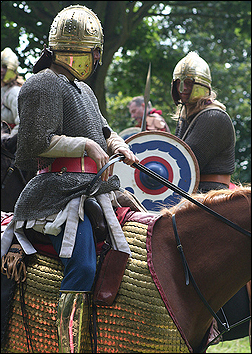





Put simply Comitatus is the home of Roman riding in Britain. In terms of equipment, horses, riders and professional display we lead the way and set the standard for others to aspire to. We actively engage Roman riding and supply other groups with saddles and equipment.
In reconstruction the major interest lies not so much in the reconstructed artefact itself, but how it is used and how it functioned. In the field of reconstruction, Peter Connolly’s work on the Romano-Celtic saddle stands out as the premier example of what can be achieved. Connolly used the surviving evidence in the form of leather covers, their stitching, stretch and wear marks, as well as metal horn plates, to produce a working Romano-Celtic saddle. He produced a design based upon a solid wooden four-horned frame. Since then a piece of wood has been found at Carlisle which corresponds to the cantle of Connolly’s proposed saddle frame, and surviving leather covers show wear marks evidencing wooden side boards belonging to a frame. Connolly produced around 25 working saddles and Comitatus is now also producing them.
However this accepted view is still regularly challenged by some and the construction of Roman saddles is still a source for debate, not all of it friendly. Various other attempts have been made to reproduce four-horned saddles using alternatives to the solid wooden frame, in part perhaps to justify simpler and cheaper reconstructions. The size of the existing leather covers and the function of the copper alloy horn plates are still a source for experimentation. However all the points regularly made by contributors to the debate today were first examined by Peter Connolly and Carol Van Driel Murray in their article “The Roman Saddle” in Britannia Volume XXII, back in 1991.
Comitatus has demonstrated that wooden framed saddles can be used on a variety of horses using furs, padding and appropriately folded saddles cloths. We have developed the Connolly design of saddle based on two saddle covers presented at the Carlisle Millennium Project conference in 2004. These covers used roughly the same stitch pattern used on other examples, but these covers retained trapezoidal flaps of leather which would hang down the sides of the horse. They demonstrate that rather than just being sewn up under the saddle as originally believed, leather covers could be secured over the horns and wooden frame of the saddle. The triplet straps could be used to secure the leather cover to the wooden frame.
The size of the horse used is vital to establish the speed of manoeuvre. Much work needs to be done in terms of tack and Roman bits, yet many period bits are now perceived and understood to be cruel, and it is not necessary or desirable to reconstruct them to manoeuvre or control the horse.
Click on the articles in the list below. They are stored as either Internet pages or PDF files.
The History of the Equites Taifali
The origins of the Late Roman Cavalry unit stationed in Northern Britain in the 4th Century.
Recreating the Roman Cavalry
Summary of the research and experimental findings to date.
Roman Horse Armour
Photos of Roman Horse Armour made by group member Mark Caple
Recreating a rider from any period requires not just the correct equipment, but some sense of period riding style. To a modern rider historical riding styles can seem strange, silly or just wrong, but they can teach a great deal regarding how equipment was carried and used. There is a great difference between a horseman and rider, and it is all too easy to possibly consider the ancients as just riders. But we should not doubt their ability and expertise on horseback which in some ways is far superior to ours. Riding bareback without reins controlling the horse with the legs, voice and balance, the ancient rider could use his bow and other weapons at the full gallop in war.
Reindeer may have been the precursor to the domestic horse by 2,000 years, living across the steppe and only later moving further north. Reindeer were used to pull sledges and were certainly ridden. By 3,000 BC these nomadic peoples were going to war on horseback. Saddles and stirrups are not essential for riding the horse, but the bridle is more important. Initially probably no more than a halter and rope supplemented by a stick, the rope was eventually placed in or around the horse's mouth, with metal bits appearing around 1,300 and 1,200 BC.
The infirm and women may have ridden side saddle, as did Assyrian Kings when perhaps riding astride was not respectable. But a firm seat sitting astride the horse is the basic requirement to use weapons.
Select a link below to read about each section:
Xenophon and the Greeks
Scythians and simple saddles
The saddle, Romans, frames, pads and reconstruction
The Steppe saddle
Stirrups
Classical riding
The modern era
And finally...